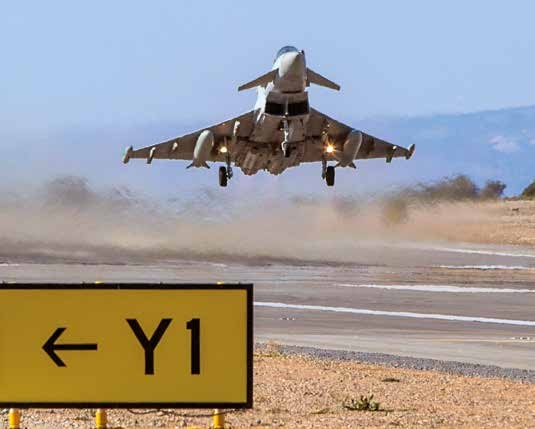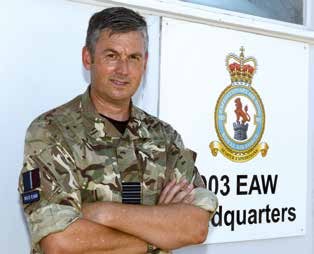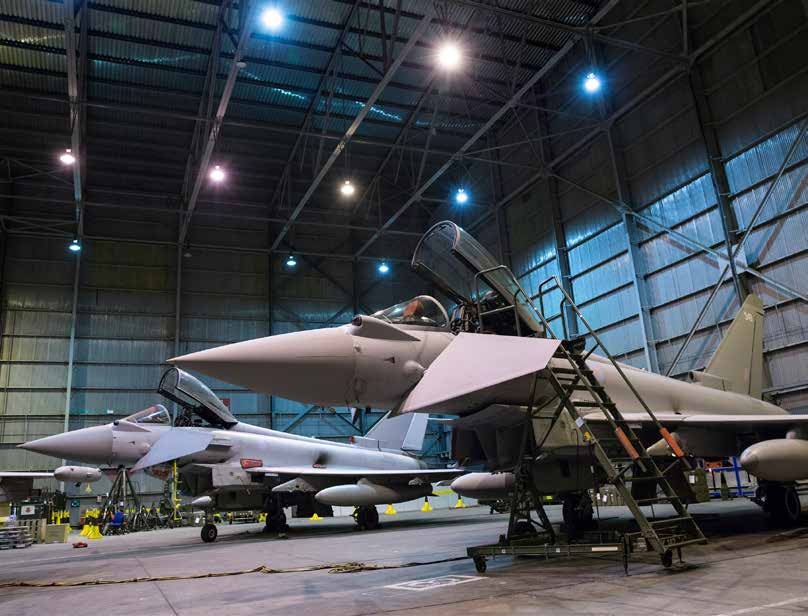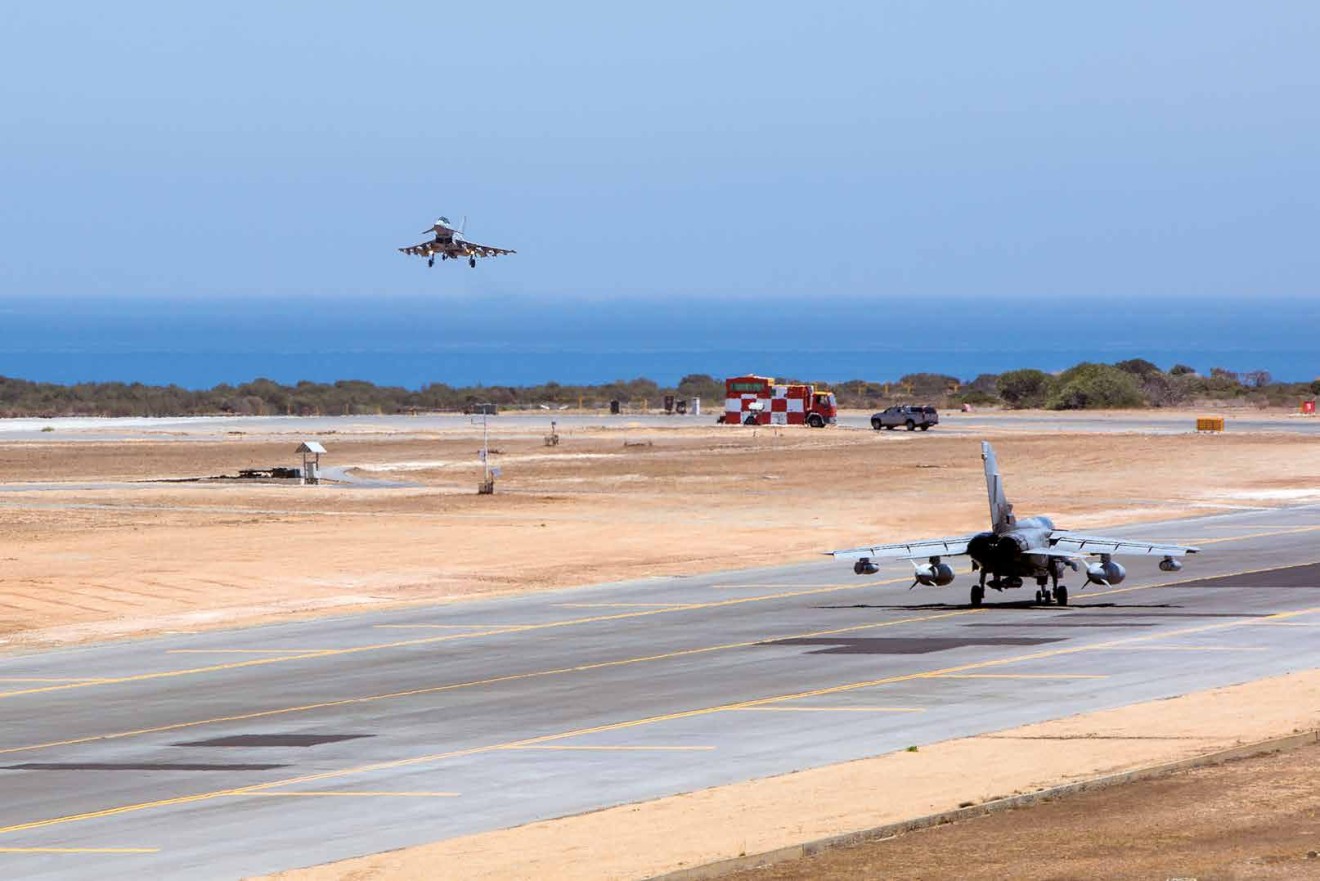
The holidaymakers on Lady’s Mile Beach in Limassol receive an early morning wake-up call. It’s 7.38am, but a pair of RAF Eurofighter jets have just roared off to work. Their exact destination remains a classified secret but as part of Operation Shader their objective is clear — to defeat Daesh across Iraq and Syria.
Fighter jets on operational duty are a fact of life on sun-kissed Cyprus, where the UK has a Sovereign Base at RAF Akrotiri in the south of the island, a 25-minute drive from Limassol.
This particular pair of Eurofighters were facing the prospect of an eight-hour working day, consisting of a series of refuelling stages and a visit to one of most dangerously-congested pieces of airspace on the planet.
This is what ‘taking the fight to Daesh’ actually means. There’s a regular drumbeat of daily missions from coalition partners. On a day–to-day basis this involves some of the RAF’s six Eurofighter Typhoon and eight Tornado aircraft stationed at Akrotiri, along with a Voyager air-to-air refuelling tanker and a Sentinel aircraft, which are all permanently allocated to 903 Air Wing.
Seventy seven nations form the coalition and their aim to date has been to squeeze Daesh out of the territory they’ve held in Iraq and Syria and to destroy their resources. So far it’s been highly effective but that’s not to say it’s been straightforward.
“Syria is one of the most complicated air campaigns I have ever been involved in,” says Group Captain Chas Dickens, Commanding Officer of the 903 Expeditionary Air Wing (EAW) at RAF Akrotiri.

Group Captain Chas Dickens
“Daesh has been severely degraded but they are not defeated. It will not be long before we have destroyed the caliphate in terms of the land it holds but now we need to defeat them as an organisation. We need to disrupt their networks and their abilities to resupply. And that will take time.”
However, their success to date has brought its own challenges. “The issue with Daesh being reduced to a very small area means there is a serious concentration of aircraft, manned, unmanned, and attack platforms all in quite a small amount of space,” says one of the RAF pilots who has flown multiple missions into Iraq and Syria.
“In such a busy airspace the biggest threat is other aircraft. The Eurofighter’s radar is key, particularly after refuelling, because it allows you to get back into your airspace and see who is in there. Effectively it ensures you’re safe because our biggest concern right now isn’t enemy action but our own aircraft. We have to make sure we stay away from each other.”
MORE THAN 1,700 STRIKES
The RAF conducted its first strikes against Daesh in 2014 and since then has carried out more than 1,700 over Iraq and Syria (about 1,400 have taken place in Iraq). Throughout most of this time Eurofighter has been a key player in the action. And it has performed well under pressure.
“It’s a great aircraft to fly, you have so much thrust available, and even in its Operation Shader weapons-fit (when it carries a mix of bombs and missiles depending on the mission) there is no need to use afterburners to get airborne,” says the pilot.
He explains that the aircraft’s sensor fusion capabilities mean he doesn’t have to worry about what each particular sensor is seeing, rather he can be confident he is receiving “a clear picture of what’s out there.” Which is far better than having lots of sensors showing you lots of information concurrently.
“As a pilot what you want is the aircraft to make it easier to process the information and help you understand what’s going on. That allows you to make valid tactical decisions at the right time. It’s a great suite and there’s great capability in the aircraft.”
With Daesh squeezed into a smaller pocket, Group Captain Dickens says the biggest challenge for Operation Shader right now is finding the enemy. The Sentinel goes out and searches an area, typically around 50sq miles. He says: “We are looking to establish a pattern of life and seeing what is going on on the ground.”
Over time this activity — which he describes as ‘armed overwatch’ — allows the force to build a clear intelligence picture. Then other assets like the Eurofighter Typhoons, with their advanced targeting Litening pods, are used to add to that picture. Essentially there’s a stack of aircraft constantly monitoring small areas.
“We look at where the friendly forces are, where people are going, and for an established pattern of life. Then we look for changes to try and understand them. Then it’s a case of putting the pieces together so that we can target the enemy should they present themselves. Once we have established where Daesh are, that’s where combat air comes into play.”
However, the aircraft are still asked to operate in some of the busiest, most dangerous airspace on the planet. From a pilot’s perspective the Eurofighter Typhoon is more than up to the task.
“It offers excellent countermeasures and a lot of work goes on behind the scenes on these. It give me a great awareness of who is around, who is looking at me and who may be a threat.“The helmet is another great strength. In the busy airspace we’re operating in, in the middle of the Euphrates, the ability to cue something with your helmet and take a closer look at it is huge. It allows me to safely fly my aircraft and manage a formation in a very busy piece of airspace.
“If I see something of interest on the ground — say an explosion or something happening — I can rapidly move the sensor to it in a matter of seconds and use the targeting pod to take a closer look.”

NEAR PERFECT RECORD
Back on the base, despite the constant breeze from Limassol Bay, it’s hot and humid. For the engineers, the shade of the hangars reduces the intensity of the heat —but only a touch. The good news for them is the Eurofighter’s near-perfect maintenance record, which in the light of the heavy mission workload is incredible.
The RAF is the second largest contributor to the campaign and its ‘attack assets’ — Eurofighter included — are in constant daily use.
“Up to this point we have carried out 299 sorties since our Squadron was stationed here a couple of months ago and we haven’t missed a single mission due to engineering issues, which is fantastic,” says one of the engineers.
“At any one time we have five aircraft serviceable and one in the hangar for planned work. Our mission availability is running at 99 percent,” he adds.
For now, the RAF’s contribution to Operation Shader is proving to be a success and for Group Captain Dickens there’s a genuine sense of pride about the work that’s being undertaken at RAF Akrotiri.
“Daesh is probably the most despicable group I’ve ever seen and I have previously been involved in operations in Iraq and Afghanistan. My crews have seen Daesh do some things to people I have not seen in other campaigns. It’s a particular nasty bunch of people.
“We are trying to defeat them and trying to stop them from exporting terrorism around the world. What we have done here has been able to keep the public back in Europe and the UK safe and make the life of the people in Iraq and Syria better. For me that is our mission’s lasting legacy. So my sense when this is over will be pride in a job well done.”
